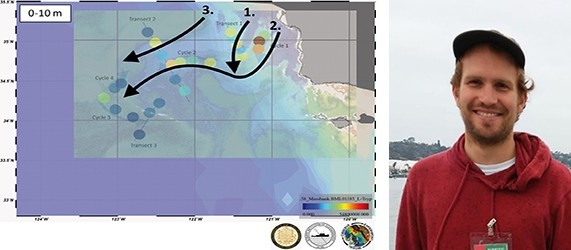To study the community metabolome during a phytoplankton bloom in the California Current Ecosystem, we applied large scale water sampling, covering different stages of the bloom. After solid phase extraction and subsequent non-targeted high-resolution liquid-chromatography tandem mass spectrometry (LC-MS/MS) analysis, we aligned exact masses from extracted ion chromatograms with MS/MS information in spectral networks. Besides the annotation of a multitude of primary metabolites, we could also identify species-specific secondary metabolites such as algal toxins. Our results showed that different stages of the bloom have clearly distinguishable chemotypes, depending on microbial community composition, nutrient concentrations, and physical properties of the water mass. Through correlation analysis and multivariable statistics, we could determine molecular drivers of the different stages, enabling a connection of molecules to community members and environmental factors.
Besides important biological implications, this study is the first large scale application of LC-MS/MS for the analysis of DOM, showing the enormous potential of this analytical approach. We anticipate, that these developments, together with next generation sequencing and meta-proteomics, will pave the way to a more comprehensive understanding of the role of DOM in marine ecosystems.
Daniel Petras did his masters in biotechnology at the Hochschule Darmstadt and the Universitat Politecnica de Valencia. In 2012 he joined the group of Roderich Suessmuth at the Technische Universitaet Berlin as a PhD student, working on the discovery and biosynthesis of natural products. After obtaining his PhD in 2016, he then joined the group of Pieter Dorrestein at the University of California San Diego, one of the leading groups on mass spectrometry based metabolomics, as a postdoctoral researcher. Currently he is working on linking metabolomic and metagenomic information from environmental samples with a focus on marine systems.
Colloquium: Marine Environmental Metabolomics - Spatial Imaging of a Phytoplankton Bloom in the California Current Ecosystem
Date: Thursday 22nd March 2018
Dissolved organic matter (DOM) is one of the most complex community metabolomes on earth and primarily the product of interactions between the upper ocean’s microbial food web and downstream abiotic chemical modifications. Analyzing the chemical composition of DOM is important for determining the rate and extent of element exchange between inorganic reservoirs and the marine biosphere and of central importance for illuminating microbe-microbe interactions within these communities.
